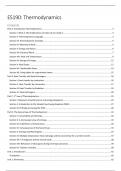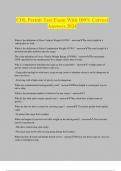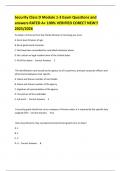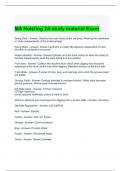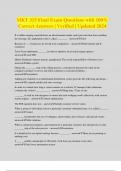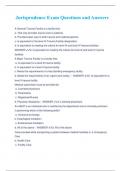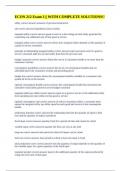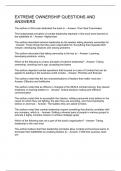Contents
Part A: Introductory Thermodynamics ............................................................................................................................. 3
Section I: What is Thermodynamics and why do we study it ....................................................................................... 3
Section II: Thermodynamic Language ........................................................................................................................... 3
Section III: Thermodynamic Concepts .......................................................................................................................... 5
Section IV: Mechanical Work ........................................................................................................................................ 5
Section V: Energy and Power ........................................................................................................................................ 6
Section VII: Electrical Work ........................................................................................................................................... 7
Section VIII: Heat and Temperature ............................................................................................................................. 9
Section IX: Storage of Energy ...................................................................................................................................... 12
Section X: Ideal Gases ................................................................................................................................................. 12
Section XI: Condensable Gases ................................................................................................................................... 14
Section XII: Using tables for superheated steam ........................................................................................................ 15
Part B: Heat Transfer and Heat Exchangers .................................................................................................................... 16
Section I: Heat transfer by conduction ....................................................................................................................... 16
Section II: Heat Transfer by Convection...................................................................................................................... 17
Section III: Heat Transfer by Radiation ....................................................................................................................... 19
Section IV: Heat Exchangers........................................................................................................................................ 20
Part C: 1st Law of Thermodynamics................................................................................................................................. 23
Section I: Measures of performance and energy dissipation ..................................................................................... 25
Section II: Introduction to the Steady Flow Energy Equation (SFEE) .......................................................................... 27
Section III: Enthalpy and using the SFEE ..................................................................................................................... 30
Part D: The Second Law of Thermodynamics ................................................................................................................. 32
Section I: Irreversibility and Entropy........................................................................................................................... 32
Section II: A microscopic view of entropy ................................................................................................................... 33
Section III: A definition of temperature ...................................................................................................................... 34
Section IV: Consequences of the Second Law ............................................................................................................ 35
Section V: Entropy and Real Engines .......................................................................................................................... 37
Section VI: Multiple temperature heat exchange and the second law for a control volume .................................... 37
Section VII: T-S Diagrams and the Carnot Cycle .......................................................................................................... 38
Section VIII: Behaviour of ideal gases during isentropic processes ............................................................................ 39
Section IX: Turbines revisited ...................................................................................................................................... 40
Unit 1: Introduction ........................................................................................................................................................ 41
Gravitation .................................................................................................................................................................. 42
Unit 2: Kinematics ........................................................................................................................................................... 42
, Linear Motion.............................................................................................................................................................. 42
Cartesian Coordinates ................................................................................................................................................. 43
Week 3: Kinetics .............................................................................................................................................................. 43
Newton’s 2nd Law (F=ma) ............................................................................................................................................ 43
Friction Forces ............................................................................................................................................................. 43
Kinetics in other coordinates ...................................................................................................................................... 44
Unit 4: Energy.................................................................................................................................................................. 45
Work............................................................................................................................................................................ 45
Kinetic Energy ............................................................................................................................................................. 45
Potential Energy, Conservative Forces........................................................................................................................ 45
Conservation of Energy ............................................................................................................................................... 46
Power .......................................................................................................................................................................... 46
Efficiency ..................................................................................................................................................................... 46
Reprise: Collisions ....................................................................................................................................................... 46
CHECK FOR FINISH OFF SECTIONS AND ADD IN RECAP AND SUMMARY NOTES LATER IN
,Part A: Introductory Thermodynamics
Section I: What is Thermodynamics and why do we study it
Thermodynamics: Study of energy in systems, their changes of state and their interactions with the surroundings.
Microscopic – Start with equations of motion of the gas molecules, consider these statistically, derive large scale
properties (STATISTICAL MECHANICS – NOT COVERED)
Macroscopic – Deal with large scale properties (e.g. volume of gas, pressure etc) without considering the microscopic
nature (THERMODYNAMICS – COVERED)
Laws of Thermodynamics:
0. Temperature – Two systems in equilibrium with a third system are in thermal equilibrium with each other
1. Conservation of Energy – Energy can change forms, but is neither created nor destroyed (i.e. total energy is
always the same)
2. Entropy of an isolated system always increases (i.e. heat flow from hot to cold)
3. Entropy of a system approaches a constant as temperature approaches absolute zero
Section II: Thermodynamic Language
System: The portion of the universe we select for investigation
• Open: Allow mass in or out (or both)
• Closed: Does not allow mass to enter or leave the system
• Energy can enter or leave (or both) an open or closed system
Surroundings: Everything outside the system
Boundary: What separates the system from the surroundings
• Adiabatic (or Adiathermal) Walls: Prevent thermal Interaction
• Diathermal Walls: Allow thermal interaction.
o Two systems separated by a diathermal wall are in “Thermal Contact”
Types of Thermodynamic Variables:
• Extensive: Variables which correspond to the amount of substance being measured, some measure of the
system as a whole. Can only change with time. (e.g. Mass, Volume, Length)
• Intensive: Variables which do not depend on the amount of substance being measures. Can vary with
position and time. (e.g. Pressure, Temperature, Density)
, In thermodynamics, one often sees variables in upper and lower case. Lower case variables often indicate “specific”
quantities, i.e. per unit mass.
Systems can be classified into Simple and Complex:
• Simple: The whole system is homogenous e.g. a gas in a cylinder
o The state of a simple system is completely known if we know the values of two independent variables
e.g. pressure and volume
o
o One example of a simple system would be a piston and cylinder.
o
• Complex: A system which is not simple (not homogenous).
o This may be because there is more than one phase e.g. a glass of water with ice cubes in (because of the
coexistence of H20 is liquid and solid forms)
o

